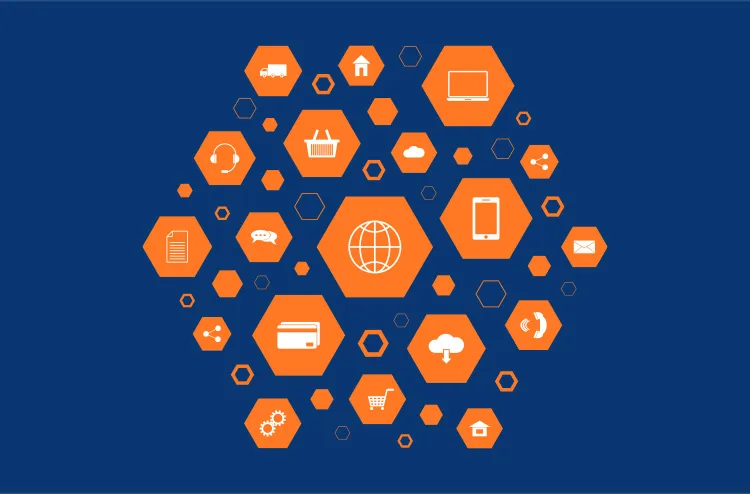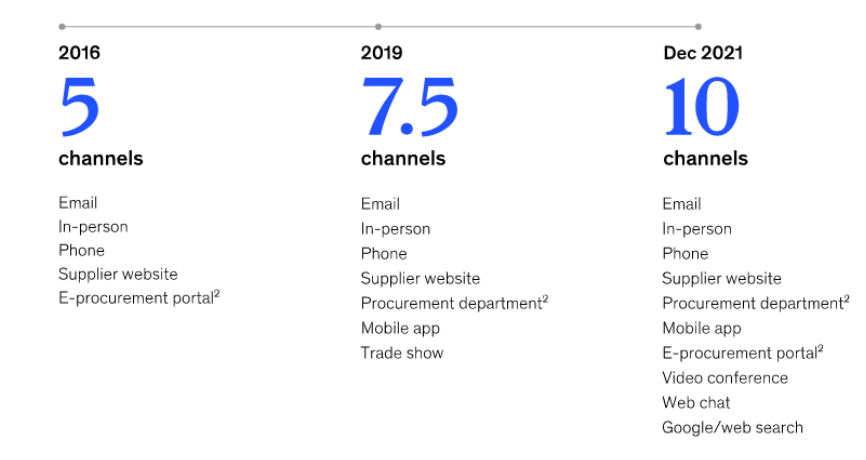Omnichannel in B2B eCommerce: trend or here to stay?
29-08-2022

The traditional b2b cycle is changing. Time-consuming face-to-face meetings with representatives are giving way to streamlined multi-channel interactions (B2B eCommerce), both off- and online.
Recent research by McKinsey shows that two-thirds of buyers, for example, choose remote human interaction or digital self-service. The latter applies to various stages of the decision process, such as identifying, searching for, assessing and evaluating new suppliers, as well as ordering and reordering. While this shift is driven in part by the risk of lockdowns and the popularity of buying online, it dovetails with a universal trend that predates the pandemic.
In this blog article, find out what wholesalers and brand manufacturers need to know about omnichannel in the modern b2b landscape and why it's important to take note of this trend, which we can safely see as here to stay.
Omnichannel is a holistic, fully integrated experience that ensures a uniform level of quality across all communication channels. In 2016, for example, the offer of an average b2b company consisted of only four or five touchpoints: email, physical contact with a salesperson, telephone, the website and sometimes another digital sales channel. Meanwhile, the number of touchpoints has doubled to tripled. Mobile apps, chat, eCommerce and dealer portals, and video calling have also become indispensable.
According to McKinsey, eight out of ten B2B leaders consider omnichannel to be a more effective strategy than traditional sales, communication and marketing methods. And a whopping 83 percent of decision makers within b2b companies believe omnichannel is the most successful way to acquire and secure new customers.
B2b buyers today expect the same level of omnichannel service and flexibility that they experience as consumers in everyday life. They want to be able to switch from channel to channel as they progress through their customer journey. Think about starting to explore their options on a vendor's website or a social media channel. Do questions bubble up? Then customers want to be able to open a chat or call a salesperson. They expect a quick response and assume (provided they have agreed to data collection) that their sales history is known and the salesperson has the knowledge to provide targeted and personalized sales advice.

Although every b2b company is unique, there are a number of universal factors that leave a significant mark on b2b omnichannel. We take a closer look at the most important ones.
Customer expectations are not static but changeable. As soon as customers discover a valuable new feature, they expect your brand, shop or company to offer it. Buying behavior in both the b2c market and the b2b market has completely changed over the years. It doesn't matter how loyal a customer is: if he is happier with the experience of another brand, he will definitely switch. So always make sure you have a sharp insight into current customer needs and adjust your channels accordingly.
Providing the best possible customer experience is just as essential as uniformity of information across different channels. A customer experience is a combination of various factors. Think about the quality of your data and product information, UI, UX, support, navigation, knowledge of your staff and the speed of a website and shop.
You need to pay attention to every little aspect of each channel. You never know if a customer is scrolling through products on a desktop and makes the final purchase on a phone. Are your web pages not optimized for mobile? Then there is a good chance that the customer will still refrain from placing the order.
Exceptional digital customer experiences are supported by technology, or rather, integrated technologies. A seamlessly integrated technology stack is a prerequisite for a streamlined experience. That's why it's so important to take a holistic approach to all technology decisions and choices.
In the past, setting up new channels could be a complex and time-consuming task. By leveraging modern API-first commerce, this is no longer the case. b2b companies now have more flexibility to deploy and manage a wide range of commerce services and systems, all from the same back-end.
An omnichannel strategy for sales and marketing requires high availability and accessibility of data, as well as the ability to share key data organization-wide. You can do this by integrating and synchronizing your ERP, platforms and tools for eCommerce. That way you get a complete picture of your customers. You offer personalized experiences at every stage of the customer journey, regardless of which channels visitors and customers use.
An integration of ERP and eCommerce also simplifies and diversifies the ordering process. For example, customers can easily purchase products online and pick them up in the physical store. An order ordered online is also immediately available in the ERP, providing customer service with the information needed to give the right product to the right customer. Is stock limited or out of stock? Then update the website and shop directly via the eCommerce platform. In this way, customers always have accurate information.
A good integration between your ERP system and your eCommerce platform has many advantages. Get to know the 9 most important ones in this whitepaper.
Even in the world of B2B eCommerce, the adage "to measure is to know" applies. So keep testing. Is my current strategy and approach still working? How do they compare to alternative methods? Keep testing, experimenting and improving to find the best possible omnichannel approach for your organization.
Omnichannel is often lumped in with other e-commerce buzzwords. But it's certainly not a fleeting trend. Is it also the right choice for every business? Not necessarily. If you like selling on one platform or can manage your social media and sales channels just fine without extensive analytics, you may not need to rethink your strategy. But for companies that want to grow, expand into new channels (or are already present on a diverse spectrum of channels) and increase their efficiency and conversion, investing in a better omnichannel experience is often worthwhile.